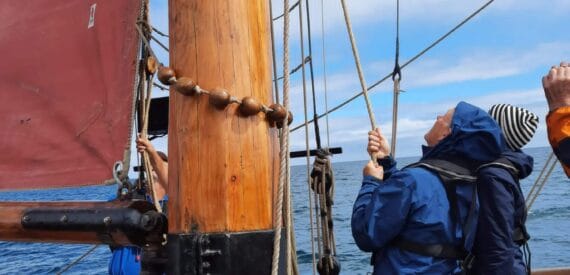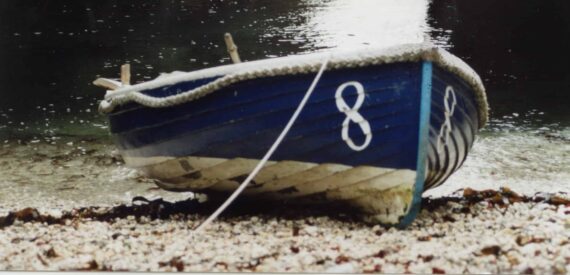The prospect of feeling nauseous on board ship puts a lot of people off sailing. Famous cases don’t help matters. Darwin called his mal-de-mer “The misery…far far beyond what I ever guessed at…” . Seasickness can be built up in such a way as to prevent you trying something new. When that something new is traditional sailing, which in our humble opinion is one of the most life-affirming and joyous activities there is, then that’s a real shame.
Many of us have experienced seasickness. However it’s important to remember that the vast majority of people acclimatise very quickly to life at sea. A commonly heard sailor’s boast is ‘I NEVER get seasick’. While this is rarely entirely true, most sailors have only been seasick once or twice during a whole career at sea. So it’s not as common as all that.
We’re here to take the dread out of seasickness (it’s as much a mental affliction as a physical one). We’ve pulled together some prevention and remedy tactics, as well as a few observations which should help.
If you’re still concerned, there are a few voyage types which are fairly safe bets. Try a day sail to get a feel for things. Round trips are also fantastic. Both of these provide the skipper with complete flexibility. They can choose the most comfortable wind directions and the most sheltered seas possible, given the conditions. Facing your fear and getting out on the water will be 99% of the battle already won.
First, what even is seasickness?

What Causes Seasickness?
There used to be a widely held belief that motion sickness was a response to a perceived threat of poison. This is largely disputed now, although the precise physiological causes are still being argued. The generally held theory is that nausea is a result of a disparity between the senses. A combination of the senses of sight, sound, balance and proprioception (our sense of where our body is).
Certain groups are more prone to seasickness (children, those who get migraines and, according to recent research, poor sleepers). However, there are things that everyone can do to lower their chances of feeling ill at sea. If you do start to feel seasick, there are also things you can do to help the symptoms pass.
How do you Prevent Seasickness?
– Tell yourself that everything will be fine! Seriously. People who step aboard with a ‘feeling’ that they’re going to get seasick are much more likely to feel it than those who have told themselves the opposite. If you don’t LOOK for it, you probably won’t find it.
– Get the sails up! Not all motions of the ocean are created equal. Sailing with the weather is a lot more comfortable than motoring through it. Many people are surprised by this, especially if they’ve felt sick previously on motor boats or ferries, but it’s true. The ship will still move under sail, but the quality of the movement is entirely different and infinitely preferable. Except for a dead run (sailing straight done wind). Nobody’s going to argue that that’s comfortable!



– ‘Ride’ the ship. Stand up on deck somewhere safe (clip yourself on if the crew ask you to), with a good hold on something solid. Keep yourself upright by swaying with the motion of the ship. This keeps your head much more stable, thereby reducing nausea, and helps your body make sense of the movement. You’ll find you’re steadier on your feet if you do this regularly.
– Take travel sickness medication. Professional sailors sometimes avoid this, as the pills can cause drowsiness. That makes standing a night watch a bit tricky. If you’re going on a sailing holiday, though, the most important thing is that you enjoy it. Take whatever precautions you need to in order to feel confident. Always make sure you talk to your pharmacist and read the instructions carefully. Seasickness tablets usually need to be taken in advance of sailing. Don’t wait and see if you feel sick before taking them. There are also travel sickness patches which you stick just behind your ear. These slowly release anti-nausea medication into your system. Some people swear by these to ensure that their first 24 hours at sea are trouble-free.
– Use pressure-point wristbands. Speaking from personal experience I was sceptical about these, but they worked brilliantly for me. Cooking a fry-up for 16 in a rolling galley with no natural light or fresh air…piece of cake! The important thing is to make sure they are positioned correctly. You’ll be able to tell when they are as the pressure point on the inside of your wrist is sensitive. They don’t work for everyone, but if they do you’ll be sorted for life.
– Avoid caffeine, nicotine and rich food, all of which can kickstart nausea. Try eating fairly plain food ‘little and often’. A slice of toast every couple of hours keeps your stomach settled. Ginger is also a much used anti-nausea remedy. Most ships carry some ginger-beer or ginger tea on board for this very purpose. You could also take along a bag of crystallized ginger for chewing if the weather picks up.



– Get plenty of fresh air, stay warm, and keep your eyes on the stable horizon. This gives your body a reference point by which to make sense of the movement, and thereby reduces nausea.
– Try and get plenty of sleep. An eye-mask and good earplugs can really help with this, and stop your senses getting confused. If it is a bit rocky, rig your lee-cloth and wedge yourself in with a pillow or your bag. This stops you rolling around as you sleep. Your body does a lot of ‘getting used to’ while you’re snoozing. Even if you were feeling a bit iffy the day before, you’ll likely wake up with your sea-legs.
– Get busy. If you’re mind is occupied you’re much less likely to feel ill. One of the absolute best remedies for someone feeling the first twinge of seasickness is to helm. Make sure you’ve got enough layers on to stay cosy, and then take a spell steering. Helming not only gives you something to do, but it keeps you looking up, at the sails and at the horizon.
And Remember…
– The crew want everyone on board to enjoy themselves. They will plan the voyage in order to reduce uncomfortable conditions.
– There is no shame in feeling queasy. Talk to the crew at the very first signs so they can help you.
– It will pass. Even if you do feel seasick, know that it won’t last forever. Once it’s over you’ll be acclimatised and unlikely to get ill again during your voyage.
– Keep warm, this is very important. If you find it more comfortable on deck you must have warm clothing.
– Talk to us: if you are still worried about seasickness then get in touch. We can help you find voyages in sheltered waters that might suit you better.






